Towards the end of 2016 I was looking for a new challenge. I had been a member of the National Scout Active Support Unit “Scout Radio” for a few years as a team member on radio stations at Uk Jamborees, usually presenting a late night show and helping with an activity for the scouts. My friend John pointed me to “Spejdernes Ljer 2017 – a huge Jamboree in Denmark where they were looking for people to join the radio station team.
So I applied, was accepted, and so my net adventure was set.
Spejdernes Lejr – Meeting the Team
At the end of April 2017 I set off to Denmark for a training weekend for the Jamboree Media teams – Video, Photography, Newspaper, Press, Social Media and of course Radio. We were to meet at a school in a village near Sonderborg on Friday evening which of course meant that I was travelling most of the day. Drive to Heathrow airport in London, fly to Hamburg in Germany and then drive up to Denmark.
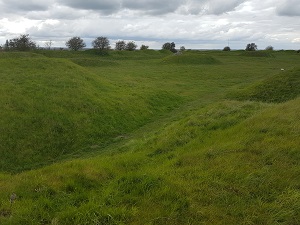
I arrived early and was treated to a tour of the historic Dybbøl Bank battlefield by our team leader Toke. Then we had dinner in town together before meeting the rest of the team at the school. A fter introductions and a brief outline of what was to come the rest of the weekend the evening was really more of a social occasion that anything else. Everyone was very welcoming – and spoke good English!
All day Saturday and Sunday morning we worked on interview techniques, programme planning, finalised the programme schedule and the teams presenting them and had talks about the aims of the Jamboree.

One of the highlights was a tour of where we will be working during the event. in this picture we are stood about where the Radio station will be and in the background are the buildings where all the Jamboree Media and Admin teams will be working.
The station is going to be different to any other I’ve worked on in two main ways. Firstly programme presenters will not be self-controlling as the mixing of output from microphones, music tracks, jingle etc will be done by a technician in a control cabin. Secondly there is no studio (!) – instead all presenters will be on a stage in the main square.
Apart from myself and a few of the others the team is very young, and quite a lot of them have almost no radio experience, but I was very impressed with how much self-confidence they have and how quickly we came together as a team so I’m sure it will work out fine.

Danish Scouting appears to be more “traditional” in some ways than I’ve seen in the UK in recent years. It is normal to always cook on wood fires in camp (they were very surprised that we don’t!) and the campfire is a bigger part of the social life of scouting than I’m used to. I know we have campfires, but ours tend to be more of an “event” than just a nice way to end the day.
I left Sonderborg still quite apprehensive about what I’ve let myself in for but also more excited about the adventure to come. I now have a handful of Danish words and some new Scouting friends that I look forward to meeting again and working with later this year.
Spejdernes Lejr Gets Real
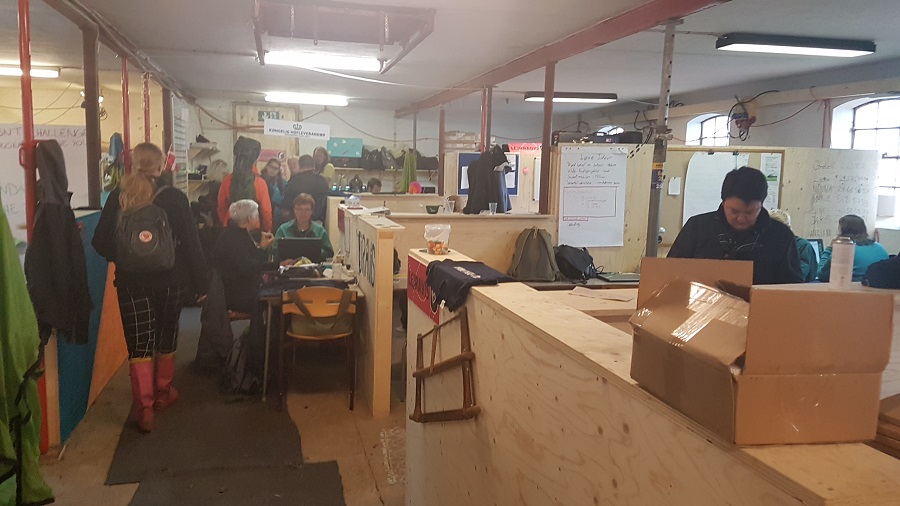
After months of wondering what I was getting into by attending the Danish National Jamboree (Spejdernes Lejr 2017) as part of the radio team I found myself sat on a train heading from Copenhagen to Sonderborg to join my Danish colleagues a couple of days before the camp officially began. My team leader Toke joined me on the train for the last part of the journey and immediately my nerves began to settle as we chatted about what was to come,
When we arrived at the site the first thing that struck me was the size of the place. The “jobber lejr” (staff camp) is about 25 minutes walk from our workplace, with the canteen we will eat in about about two thirds of the way along. Luckily there are bikes we can use to go back and forth. These bikes are “shared” and the idea is that you leave them at your destination so someone else can use them.
We are working from a barn roughly in the middle of the site (yes – that means there is another 25 minutes from here to the other end of the site!) and are part of the Communications team so are surrounded by the teams for photography, video, newspaper, social media and even translators. It’s a very busy place already and the camp doesn’t even start for anther two days. Many of our team I met briefly in at a training weekend but there are more here now – 27 altogether. I am the only non-Dane but they all speak very good English so communication is not a problem.
My tent is now pitched, I have found my workplace and found my new friends, Time to get stuck in.
The Danish Prime Minister
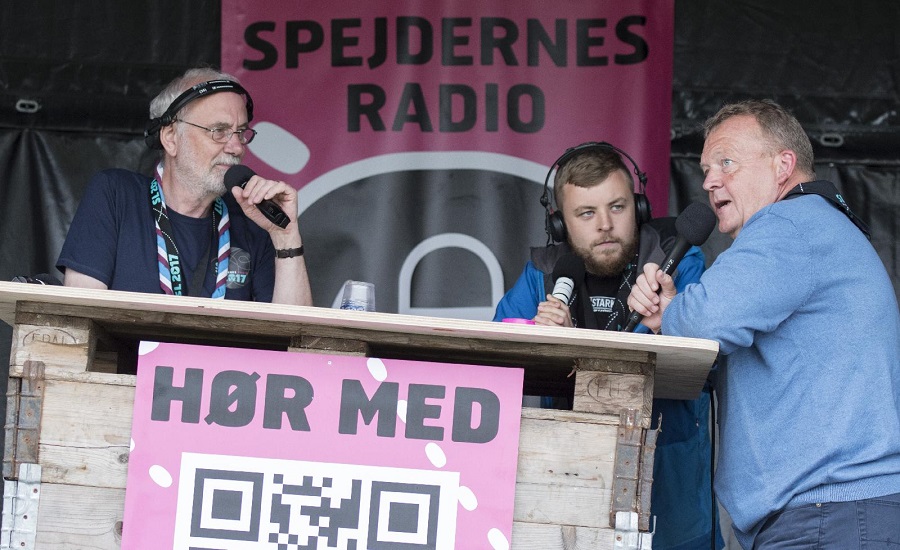
Highlight of today – was asked to work on the Morning Show with Sigurd and who should appear in front of the stage but none other than Lars Løkke, the Prime Minister of Denmark. Next thing I know he is on stage with us and we are having a chat!. I say “we” but in truth it was mostly Sigurd and a really job of it he made too. Among other things he asked if we can hold the next Jamboree in Christiansborg Palace – which is the Danish Parliament!
Later Sigurd was pronounced “Jobber of the Day” for his efforts. And well deserved too.
Danish Camping
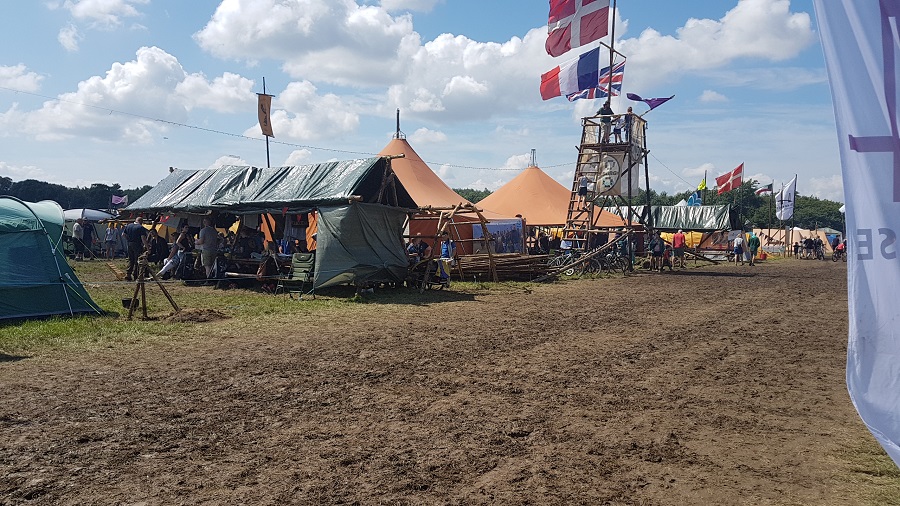
Today we started wandering round the campsite taking a look at what is out there now people are getting settled in. There is a startling difference between this Jamboree and those I’ve seen in UK. There are the things you’d expect like different styles of tents and so on, but there are two things that we definitely don’t see in UK.

The first is the pioneering. It’s on a different scale altogether. There are towers, bridges, huge gates, multi-level sleeping decks and even a windmill! When we arrived there were large piles of pioneering poles in the sub-camps stacked by size – some up to 12 metres long. Those piles have shrunk considerably in the last couple of days. It’s not unusual to see quite small scouts carry huge poles (the Danish word is “rafter”). And they don’t mess about with tools either, the most common sound heard across the campsite all day has been the sound of petrol augers drilling holes in the ground to stand the uprights in. A hole is bored, pole stood in and wooden wedges packed in to hold things upright. They don’t appear to use guys ropes at all.
Secondly is the camping arrangements. For the Danish at least it appears to be very traditional, with wood fires for cooking, wet pits, dining tables and shelters built from the rafters and so on.
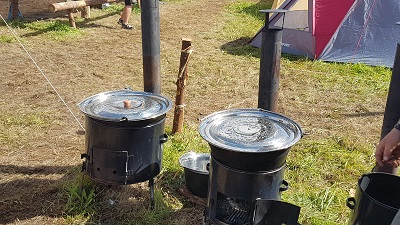
On closer inspection you can see many (many!) different kinds of oven, water heaters and grill plates being used. Some are bought but many are homemade. There is even a hot tub heated by a boiler made from an oil drum and fired by wood! The second sound heard today has been that of chainsaws as the wood for the fires is cut into suitably short pieces ready for chopping. It’s not at all unusual to see quite young children using axes and bow saws. In UK we’d probably have a heart attack, but here they obviously know what they are doing and appear to be using them safely.
All in all it reminds me very much of camping when I was a young Scout, before the days of taking tables and chairs, large marquees and gas cookers. Does anyone in UK still camp this way? I haven’t seen it for some time but then these days I tend to be going to large events where the emphasis is on activities and camping is just what you need to do to be there.
Saturday 22nd July 2017 – The Camp Begins

Today the camp started in earnest after a couple of days where the team completed the technical set up of the radio studio, we all practiced live for a couple of hours and started preparing for our programmes. I’ll be presenting an “International Show” along with a Danish lady called Maureen who I met for the first time when we arrived here. The plan is that the show will basically be in English but with some German inserts as the Jamboree has three official languages – Danish, English and German. All the rest of the day is in Danish so our job is to give something to the International scouts who are coming and will mostly have some English.
The campsite is being transformed as people arrive. The fields around are filling up with all manner of tents, shelters and constructions and I’m really starting to get a feel for the sheer size of the place. It’s all a bit different to what I’m used to in UK and is fascinating to watch grow.
Our radio “studio” is actually a stage with a control room sitting alongside. We presenters work on stage and have a view through the side to the technician sat a the mixing desk. They are playing pre-recordings that we make from our Dropbox store and are using Spotify as the music database. We’ve been on air live since first thing this morning and Maureen and I have done our first hourly show.
To be honest it wasn’t the best, but it’s the first one and we’re all bedding in. Don’t get me wrong – it was ok, but not as slick as we’d have liked. We’ll get better.
Our Team

We had a team of 27 people for Spejdernes Radio (Scout Radio). This is a much bigger team than I’m used to for a Jamboree station but then the Jamboree was much bigger than I’m used to! Our Team Leader was Toke, ably assisted by Margrethe (who is now a qualified Journalist!!!!) and the rest of the team was mainly split between presenters and technicians.
In a nutshell presenters put the shows together and were the people actually on air on the radio whilst the technicians were sat in the control room looking after the output levels from microphones, playing pre-recorded items and playing the music tracks. For me this is a new way of working since I’ve always worked on stations where we have “self-operated” – where one of the presenters is also the technician. In fact a lot of the work I’ve done has been solo, so I’ve done all the work myself.
A lot of the team had never done any radio work before but some were more experienced, especially Henrik who is a morning show presenter on Radio Sydhavsøerne (Radio South Islands). Most of the team were young, teenagers or early twenties, but of course I made up for that by being an old man. I was again struck by just how confident they appeared, quite happy to speak up and put their points of view across. I was also impressed by the fact they were listened to – not always the case in some teams I’ve been in. It was lovely to hear from some during the camp that they had been accepted into colleges and courses they had been trying for.
Unfortunately I didn’t get to know some of the team very well because basically our paths hardly crossed during the week, work rotas not matching sufficiently mostly. I would love to have spent more time with them, but the nature of Jamborees is that everything is pretty fleeting. All those that I did get to know well were very kind to the old man from England and put up with my endless questions about Denmark and Danish Scouting. (I hope I wasn’t boring them with my stories!). I will miss them.
The International Show
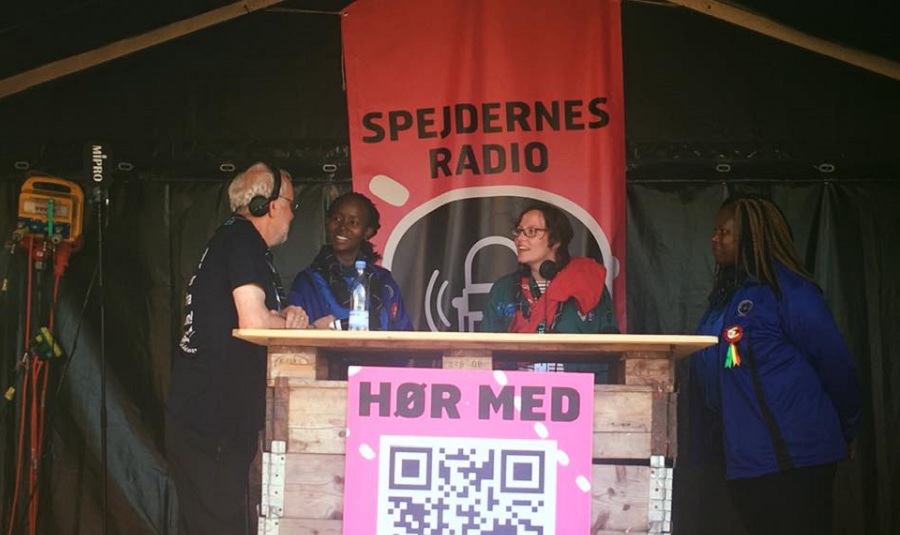
Every evening as 7pm approached Maureen and I made our way to the radio stage to present our hour long show. It was the only one not in Danish and was intended mainly for the International Scouts attending the camp. Despite only being an hour long it took most of the day to prepare as we had to find guests, get some pre-recorded interviews, pick the music, devise the quiz and so on. One of the reasons it all took so long was the sheer size of the camp. It took time to get anywhere, especially after all the shared bikes disappeared when the Scouts arrived.
During the week we had guests on stage from Zimbabwe, Ireland, UK and the Rainbow Cafe and we spoke to many other nationalities. A highlight for me was when we found Scouts for Oman and Kuwait who had joined together to teach each other their Scout songs. We also went into some of the bases on site to get interviews in English, including the Scout Museums and the Unesco tent. We even interviewed a Danish Irish folk band!
Working with Maureen was a joy and the hour on air with her was the highlight of my day. That’s not to say it was all sweetness and light, we had our moments of course, but they were trivial compared to the laughs we had together and she taught me so much about Denmark and Danish Scouting. Despite having no radio experience she had a lot of good ideas and was very good at interviewing people. We worked well together.
Our technicians were Kirstine and Jonas. Their job was to control the microphone levels and to start our pre-recorded pieces and music tracks. They were stationed in the control cabin next to the stage and we could see them through the cabin window and speak to them via the talk-back in our headsets. It was the first time I’d worked like that but after a couple of days it all bedded in and we got used to each other. They did a great job for us especially since we kept making changes to the running order during the actual programme!
The Mediagarden
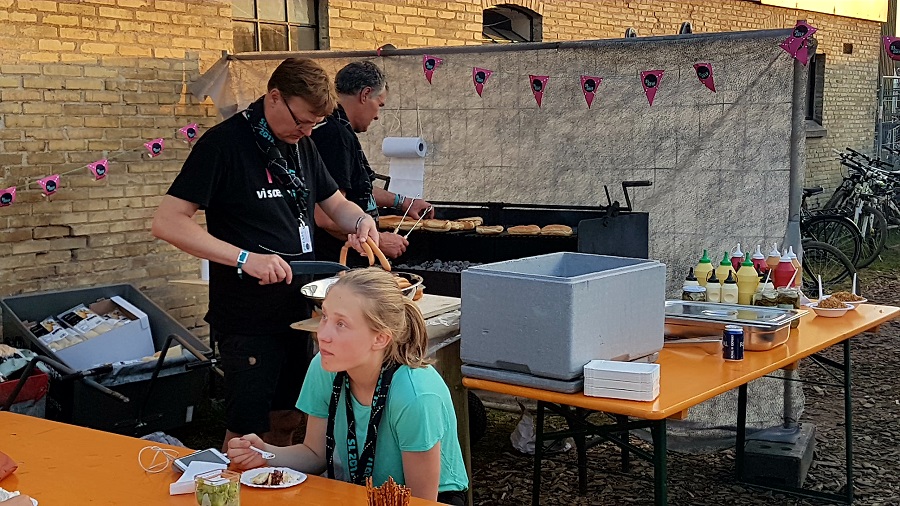
The radio team was housed in the barn pretty much in the centre of the campsite. We were working alongside teams doing the photography, videos, newspaper, social media and the translator team. In all I think somewhere between 80 and 100 people. As well as our working area we were also treated to a lounge area where we could relax. In addition to tables and chairs there were “settees” made from pallets covered in foam and coffee tables with the camp symbols on top.
On the wall was a large map of Denmark mounted on plywood and each member of the team was asked to put a screw into the map showing where they came from. It took a couple of days to find a map of the UK to add to it so that John and I could put in ours (my friend John Rogers from UK was working on the video team). Of course most people were from the Copenhagen area but the rest of Denmark was well represented.

Free tea and coffee were always available, and soft drinks and beer in the chiller at the knock-down price of 5dkk a can. This presented a small problem since we were supposed to pay be “mobilepay” which is available only to those with a Danish bank account. I solved this by counting what I drank and paying cash every ten cans (though to the casual eye might it have looked like I was stealing!).
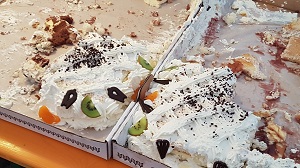
One of the highlights of the Mediagarden though was cake! I’m not sure where it all came from but cakes of all descriptions kept appearing and kept getting eaten. I’m not sure I’ve ever eaten so much cake in a week even though I was careful to be polite and only take my share. Another was barbecue night when we all ate together and watched reports of the camp on the TV news.
Looking back it appear we were quite spoilt. Definitely something I should bring back to the UK events.
Bikes
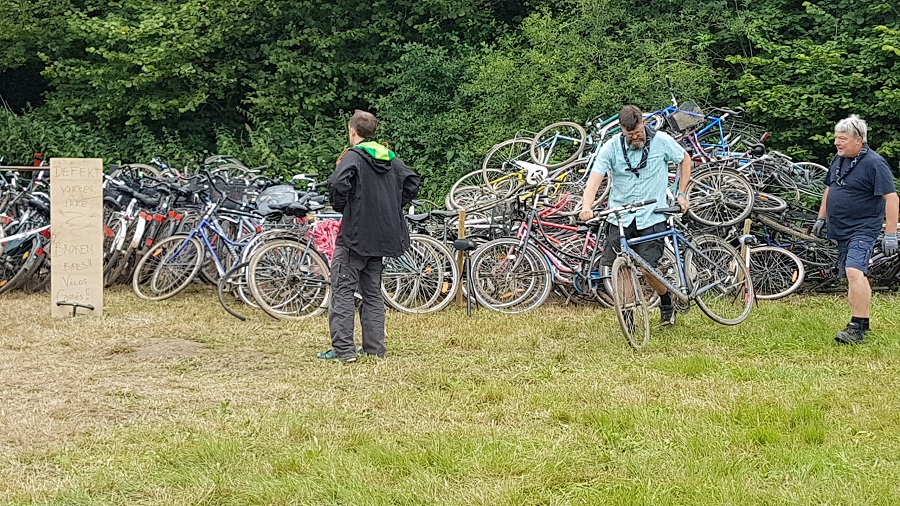
There was one innovation at the Jamboree that I was looking forwards too – the “Shared Bicycles”. The camp organisers had got together with the town and a local charity to renovate 1000 old bikes to be used at the camp. Cycling is really popular in Denmark and bikes are everywhere. The idea was that you took a bike from the nearest rack, rode it to where you wanted to go and left it there for someone else to use, picking up another one when you wanted to return.
It worked beautifully during the days running up to the Scouts arriving on the first Saturday of the camp, at which point they all disappeared! After that all you could find was broken ones. Confusingly there were a lot of privately owned bikes in the racks as well and I spent ages the first couple of days walking up and down them looking in vain for a shared bike before I just gave up and walked everywhere. Obviously not everyone was playing the game with the shared bikes. Some had even bought locks to put on them (which were being cut off as they were found). Others had taken the stickers off so they looked like private bikes.
As the week went on more and more of the bikes died and found their way onto the graveyard next to the repair shop and the pile grew and grew. Then just when when I thought they must all be gone they miraculously started appearing again the day the Scouts left. Who would have guessed!
The Birthday Boy
Now I’m going to be honest and admit that I didn’t listen to an awful lot of Spejdernes Radio. I have two reasons for this, firstly I spent most of my time either working on our own program or taking time out to look around the Jamboree although there were still large areas I never got to! Secondly it was all in Danish so I couldn’t understand anything that was said!
However I did try to go round to the radio stage for at least one show a day to watch proceedings and could see that what was being presented was very different to the radio I’ve done at Scout events in UK. I think this is mainly because it was happening on a stage, so there was an amount of “stage-show” going on which isn’t usually the case. This varied a lot between the various shows but all of them seemed to be enjoyed by those gathered around.
An excellent example of this came with Sigurd’s birthday. Somehow a local company had been persuaded to bake a giant cake for the occasion and a large crowd gathered to help eat it. Sigurd is as we say in UK “a bit of a character” and has a distinct style all to himself which the audience really latch on to. He was really in his element for this show and together with the rest of the “Portvins Patroljen” team the birthday became quite a spectacle. And yes it does mean “Port Wine Patrol” and I have no idea why it was called that!
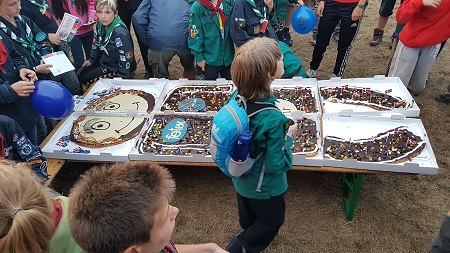
In Denmark a birthday cake (en Kagemand) is made in the shape of a man or woman accordingly and is decorated by frosting and lots of sweets. It’s apparently traditional to cut the head off first! All week I’d been seeing people walking around with boxes about the size of an A3 sheet of paper wondering what was in them, turns out it was birthday cakes. But Sigurd’s was a bit larger – taking up eight of these boxes – but didn’t last long once it was cut.
Happy birthday Sigurd!
Pind
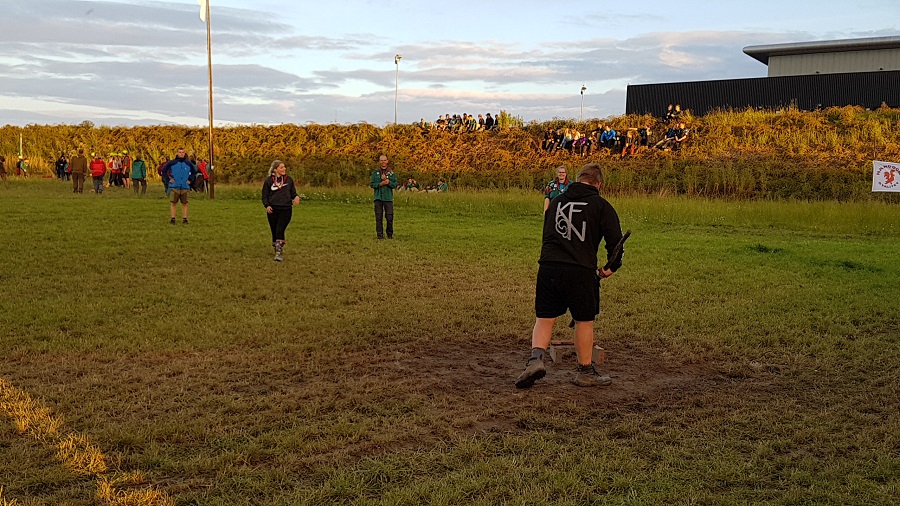
During the camp the Dansk Pind Union (DPU) held a series of “boot camps”, practice games and then a series of Pind tournaments leading to championship finals on Friday evening and Saturday morning. It was decided that the radio team would broadcast the finals live on air and in the lead up Maureen and I went up to get an English interview with the organisers.
Pind (pronounced “Pin” – the “d” is silent in a lot of Danish words) is a game played between two teams using a short stick (the Pind) and a long stick (the Pind-Pind) – or in English, the Stick and the Stick-Stick. (!). One team is “in” and the other team is fielding. Basically the Stick is placed on a couple of blocks and the Stick-Stick is used to propel the stick out into the field. It has to be “lifted”, not hit. (If “click” is heard from a hit it doesn’t count and you have to try again).
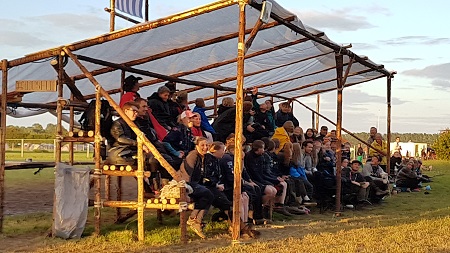
The fielding team try to catch the Stick and if they manage it you’re out. If they don’t catch it they throw it back to try to hit the blocks which you try to defend with your Stick-Stick. If they hit the blocks you’re out, if not you measure the distance between the blocks and where the Stick ended up in Stick-Stick lengths – and that is how many points you score. When sufficient people are out the teams swap over.
Simple enough you’d think, harmless fun. And it is until you find a 20cm long Stick come flying back at your shins as a fielder attempts to hit the blocks with it – or until you try to catch a whirling Stick coming down at you from height! Apparently the game has been played for at least a hundred years and there are several different versions of the game played across Denmark. For the camp the DPU had modified the rules slightly to ensure everyone had a reasonably chance and that games didn’t go on too long.
I thought it looked to be taken quite seriously until some one translated the DPU’s slogan for me – ” Nullum baculum adeo parvum ut non ludator” – meaning “No Stick is to small to play with”!
Hygge
“Hygge” has become a popular thing among the chattering classes in UK. There are lots of books explaining how you can achieve hygge, some of which are laughable to anyone with an ounce of common sense. Elle Magazine for example advises buying candles, making some poppy seed rolls and saying “hygge” at every opportunity – “I can’t come out tonight, I’m going to get some ‘hygge'”. Basically they have no idea, it’s just a fashion , a fad that will disappear when the next bright idea comes along.
The Danes I spoke to were pretty dismissive about this, and rightly so. They are not, however, dismissive about hygge. It’s real, it exists and they love it. They just can’t explain what it really is as it has no proper English translation. The nearest they can get to it is “cosiness”. They say you have to experience it to know what it is. You’ll know it when you feel it they say. And I think they are right, because I think I’ve been there. Let me explain.
I had a long walk of about 25-30 minutes back to my tent from our workplace each night. I tried various routes none of which were particular exciting and then one night I was walking between campsites when I spotted a Scout Leader quietly sat by his fire. I stopped and said to him that he looked relaxed. Yes he was he replied and invited me to sit with him. That night and each night for the rest of the camp we sat and chatted about our days, our ambitions, our thoughts on the world. Sometimes we didn’t talk at all, just sat and watched the embers glow. We were two guys sat by a fire in a field quietly enjoying each others company, nothing else needed. Definitely “cosiness”.
Thanks Michael.
Reflections
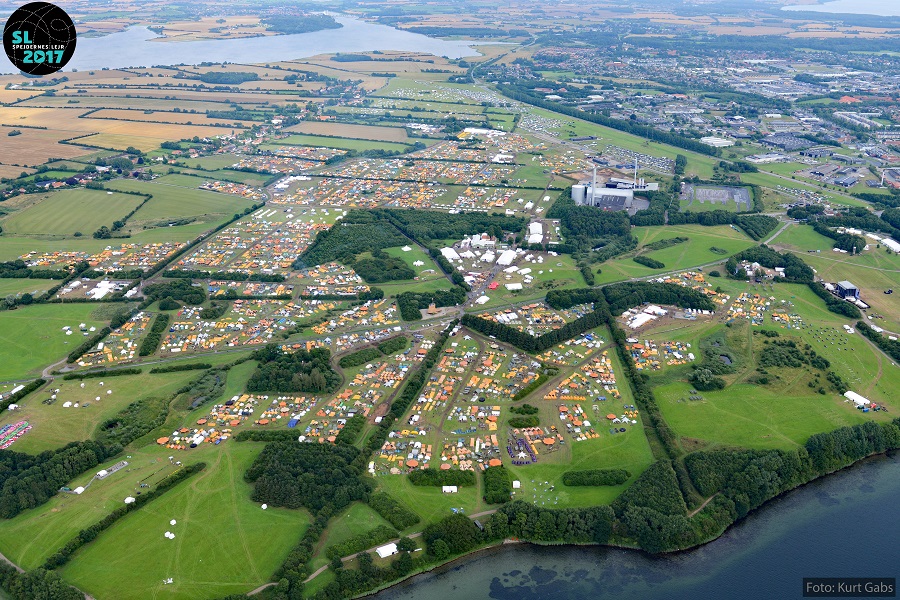
Spejdernes Lejr is the biggest Scout Camp I’ve ever been to by a country mile. There were 37,000 Scouts there, more than went to almost all the World Scout Jamborees ever held. It was also my first Scout trip out of UK since 1966, when I was only 13 years old. It was my first time at a camp where the main language wasn’t English – though almost everyone there spoke very good English. I was the only non-Dane in the team and by far the oldest member. So it was a bit of a stretch for me.
I wasn’t there completely alone though. My friend John was on the video team, and there were others I knew who were camping with their Groups. So I did have an occasional connection with home. Not that I really felt I needed it, but it was nice all the same. And of course it was a Scout camp, so there is the instant acceptance between us all of being in the family of Scouting.
In 2010 I went to my first UK Jamboree and that experience rekindled my love of Scouting. It was a mind-opening experience and was the catalyst that had set me on the road to Denmark in 2017. I remember boring everyone for weeks about it afterwards because I was so excited at what I’d seen. Spejdernes Lejr just takes that feeling to a whole new level, at times overwhelming, at times confusing, but always giving me something new. There were times when I felt a bit lost and times when I was emotional but mostly I was buzzing – some nights despite being tired I couldn’t sleep because of the thoughts flying round my head.
And the people, the wonderful team I was working with, especially my “camp mother” Maureen who quickly learnt to put me down when needed but always had a smile. Everyone on the team was very welcoming and they all contributed to my week in a very positive way. I won’t go through them all but a few examples are – Eloise trying to explain hygge, Thorbjorn and Nanna getting their college places, Emilie being surprised and happy that I managed to say her name correctly, Nikolaj being so pleased to swap scarves, the bracelets given by Kirstine and Jonas. And there are so many more memories that I will treasure.
My journey home was painful and not only because I was leaving behind some new friends that I may never see again. I had pulled a muscle or two in my back riding a bike on the last saturday and was having muscle spasms. I could hardly pick up my bag and by the time I got home struggled to even get out of the car. To add to it I left my phone on the train into Copenhagen. Frankly it wasn’t a happy ending! But even so I long to do it again, would love to see our team back together, to have another Danish adventure.
Finally, my thanks to Toke and Margrethe for giving me the chance to come to the camp and for the great support you gave me while I was there. It means a lot that at my age I can still be accepted and be part of these events.
